Fibromyalgia is something that afflicts people of all ages. There are millions of people across the world that are affected by it. There are pressure points in the body that cause pain when pressed. Fibromyalgia is diagnosed or first detected when pain shoots from any of these points through the body. There are about fourteen total pains in almost all of these are telling signs that you have fibro. A lot of people don’t realize that fibromyalgia can also cause you to feel chest pains. We are taught through many different avenues that when you are experiencing chest pain, you might be having a heart attack.
FIBROMYALGIA AND CHEST TIGHTNESS
There is a correlation between fibromyalgia and chest pain. In fact, a large percentage of the pain associated with fibromyalgia is focused around the chest. Two of the pain pressure points are around the breast bone and ribcage. This explains why your chest would feel tight because of all the pressure that is happening with the inflammation in your cartilage. Tightness doesn’t hurt but it is a very uncomfortable feeling to have to deal with.
WHAT DOES FIBROMYALGIA CHEST PAIN FEEL LIKE
Chest pain from fibromyalgia, also called costochondritis, is described as a stabbing aching pain. It can often terrify those who aren’t used to it because it can mimic a heart attack or stroke. This is especially troubling for older sufferers of fibromyalgia. It’s no picnic for the younger sufferers either. The pain you feel around the breast bone and in your rib cage is a condition that can be treated separately from Fibromyalgia.
The inflammation in your chest can range from a mild ache to a very painful problem. This depends on the amount of inflammation of the cartilage in the area. The pain can be on the left or right side of your chest, and it can be in the front or the upper part of your chest. You might feel a burning pain in the ribs or your ribs are sore when you touch them. The pain might increase when you exert yourself and decrease with rest. Different people are affected by costochondritis differently. The pain can come and go. When you have fibromyalgia then repetitive activity can cause chest pain. When you sit at a desk and lean over it all day long then it can put stress on the muscles in your chest. This is because when you have fibromyalgia your muscles are very sensitive. Having this chronic chest pain or chest pain that comes and goes can make it difficult for you to sleep. This can certainly disrupt your overall quality of life.
CAN FIBROMYALGIA CAUSE SHORTNESS OF BREATH
People who have fibromyalgia experience shortness of breath and have a hard time taking deep breaths. There are a couple of different theories as to why this is, but the most likely reason for dyspnea, or shortness of breath, is a lack of thyroid hormone regulation associated with fibromyalgia. This can cause the muscles in your respiratory system to be weak and cause them to not work correctly. The pain in your chest can also be the source of shortness of breath. You might find this is something that just comes on suddenly or you might have struggled with it the whole time. It’s always different for everyone.
CAN FIBROMYALGIA CAUSE BREATHING PROBLEMS
Breathing can be affected by fibromyalgia in several ways. It can hurt to try and take a deep breath which makes it hard to breathe because of the pain. There’s a condition that is called upper airway resistant syndrome which is often associated with Fibro. This syndrome makes it difficult to breathe and easy to become short of breath quickly. If you couple these things with the pain that radiates from the normal symptoms of Fibro then it can be almost impossible to catch a breath.
COSTOCHONDRITIS: A CLOSER LOOK AT THIS PAINFUL PROBLEM
As a sufferer of fibro, chances are pretty good you have noticed a tight feeling in your chest at one point in time or another. You may have even felt an aching or stabbing pain in your chest. There are over 600,000 cases in the world and it can start at the young age of 12. While it is common in both sexes it affects females more often. There is no definite cause that has been identified. Costochondritis is the medical name used to describe the chest pain you feel associated with fibro. This condition is technically an inflammation of the cartilage that holds your ribs to your chest bone. When the ribs become inflamed, it causes very sharp pains inside of your chest walls. The pain very commonly mimics what is often associated with cardiac pains and problems.
Statistics show that anywhere from 60 to 70 percent of individuals who suffer from fibromyalgia also suffer from costochondritis. Costochondritis is also significantly more common in women. This is especially true for women who fall between the ages of 20 and 40. Naturally, you do not necessarily have to have fibro to suffer from costochondritis. If you suffered from chest trauma or an exercise injury, you can also get costochondritis that way too. It is, however, important to keep in mind that only 10 percent of people who have costochondritis do not have fibro. The other 90 percent also suffer from fibro.

You are going to feel costochondritis hit you right between your ribs and your chest bone. This is something people commonly refer to as their sternum. There are 7 pieces of cartilage attached to your ribs and it can cause all of the cartilage to become inflamed, which can put you in an extreme amount of pain. Most people, they feel the pain from this condition on the left side of their chest. It, however, can be felt on the right side or even both if the inflammation is severe.
People who suffer from costochondritis might find exercising difficult. When you exert yourself and start to breathe hard it can aggravate it. With your lungs expanding behind your ribs breathing in and out can become very painful.
Like fibromyalgia, costochondritis does not discriminate. It can affect anyone whether they are completely healthy or active. It doesn’t care that they take great care of their body and eat right. It’s just one of those things that will happen to anyone at any time.
SYMPTOMS OF COSTOCHONDRITIS
If you suffer from fibro, these are some of the symptoms you may experience with a combination of your condition and costochondritis:
- Stabbing, sharp pain in your chest area
- Sore, tender ribs
- Pain in your upper chest area
- Burning pain in your rib area
- Pain that moves up your neck and into your shoulders
- Pain when you cough and/or sneeze
- Paint that goes away when you rest or stop moving
- Rapid beating of the heart
- Irregular beating of the heart
- Shortness of breath or trouble breathing
If you experience symptoms that involve trouble breathing or heartbeat abnormalities, it is important to get to a doctor as soon as possible. Your healthcare provider needs to make sure costochondritis and fibro are causing the symptoms and not something more serious or something treatable.
WHAT CAUSES COSTOCHONDRITIS SYMPTOMS?
As of 2015, medical experts have no idea what causes fibromyalgia or costochondritis. Research is still being done and some believe there are a number of factors that impact how fibro develops and what symptoms you experience because of it. There are some theories on what could cause it.
REPETITIVE ACTIVITIES
There are some people who believe repetitive activities may have something to do with people who suffer from chest pain due to fibro. Sitting in front of a computer desk and leaning forward for long periods of time, for example, puts stress on the muscles in your chest area. Medical experts believe this could largely have something to do with the chest pain you feel. Naturally, the solution to this problem would be to avoid doing any activity repetitively or for long periods of time that is going to put stress on your chest muscles.
TENDER POINTS
There are some points on the human body that are believed to be tender points for individuals who suffer from fibro. Medical experts believe these points, in the chest area, could trigger costochondritis. When you have acupuncture or even some types of massage, these pressure points are engaged to relieve tension. The pressing of these points in people with fibromyalgia is something that causes a great deal of pain.
INFECTION
While it is far less common, there is reason to believe a chest infection could also be to blame for costochondritis. Since it is inflammation there is a good amount of evidence that supports an infection could cause some type of inflammation and that will lead to pain and the condition.
UNDERSTANDING HOW COSTOCHONDRITIS IMPACTS FIBROMYALGIA
Costochondritis has the tendency to make the symptoms of fibromyalgia much worse. Fibromyalgia is a condition that makes it very difficult for you to participate in certain activities. It can also make it difficult for you to sit for long periods of time. When you are sitting the pain can come and go, it isn’t fun because standing up after you’ve been sitting can’t help the pain, and you have to just ride the wave so to speak. You might find jobs like waiting tables or doing yard work are completely out of your element. So if you can’t sit down and work and you can’t stand up and work it leaves you with very few options.
Costochondritis can cause such an intense amount of chest pain, that a person often has trouble sleeping as well. The biggest downside to costochondritis is that it is so common in people who suffer from fibromyalgia.
The most important thing to take in from all of this information is that chest pain is never something to take lightly. You should consult a doctor the moment you start feeling chest pain in order to determine why you are feeling it and to get the necessary help. It is better for you to know what is causing the pain. While costochondritis can mimic a heart attack perfectly, it is always better to be safe and not sorry by making sure you aren’t suffering from the real thing. Once you have the tests to make sure you aren’t having a heart attack then you can move on to figuring out what’s really going on.
PEOPLE BELIEVE UNEXPLAINED ILLNESSES
Fibromyalgia and costochondritis are one of the many invisible ailments that people suffer from. They are called invisible because people cannot actually see the outward visibility of the disease or ailment the person suffers. You can’t show someone chronic pain and fatigue. You can explain it to someone, but they might not understand it if they aren’t going through it themselves. When you suffer from an invisible disease it can be hard to get the people you work with and even your loved ones to understand what you are going through.
It might be difficult to deal with a person who thinks you are lying about having an issue and the way that you feel. You should be ready to encounter those types of people in your life. Some people are just content with hating and putting down things they don’t understand. This is one of those times when you can’t dwell on what other people think, you just have to worry about yourself. There is unfortunately not enough education out there about these kinds of ailments until someone has to deal with them personally. Maybe one day that will change.
By educating yourself about this extremely painful symptom of fibromyalgia you can be more aware of what’s happening to your body. Once you know what’s going on you can find ways to try and cope with it. There is more and more research being done trying to determine how to prevent, predict, and treat fibromyalgia and costochondritis.


I have had both fibromyalgia and costochondritis for over 40 years. I have to admit I have had enough
Hi Heidi,
I also have fibromyalgia. The pain is so intense with costochondritis. I’ve ended up in A&E a few times it’s that bad. Unfortunately people do not understand how the pain can be so intense all I can say is I wouldn’t wish it on anyone.
Take care. x